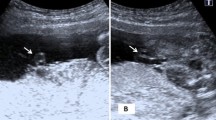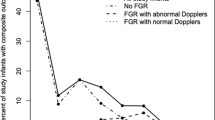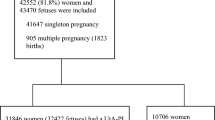Abstract
Objective:
Evaluation of the cerebroplacental ratio (CPR) as an adjunct to umbilical artery Doppler (UA) to assess risk of delivery before 32 weeks and/or delivery within 2 weeks from diagnosis of fetal growth restriction (FGR).
Study Design:
In a cohort of fetuses with suspected FGR, UA Doppler was performed, and when abnormal the CPR was calculated (middle cerebral pulsatility index/umbilical artery pulsatility index). Doppler characteristics were used to determine three study groups: (1) normal UA, (2) abnormal UA with normal CPR and (3) abnormal UA with abnormal CPR. The primary outcomes were delivery before 32 weeks and delivery within 2 weeks. Adjusted odds ratio (aOR) with 95% confidence intervals (CIs) were calculated controlling for maternal age, chronic hypertension and tobacco use. We performed a linear regression analysis comparing the value of the CPR with the gestational age at delivery. Kaplan–Meier survival curve analysis with log-rank tests for probability was performed.
Results:
We included 154 patients: 91, 31 and 32 in Group 1, 2 and 3, respectively. Subjects in Group 3 had higher rates of the two primary outcomes: there was a fivefold increased risk (aOR=5.2 (95% CI=2.85–9.48)) for delivery before 32 weeks and over a fourfold increased risk for delivery within 2 weeks (aOR=4.76 (95% CI=2.32–9.76)) compared with those with a normal CPR (Group 1). In contrast, subjects in Group 2 (abnormal UA Doppler but normal CPR) had a similar rate of delivery before 32 weeks (aOR=1.16 (95% CI=0.55–2.48)) and within 2 weeks (aOR=1.07 (95% CI=0.43–2.69)). The median gestational age at delivery was 36, 36 and 29 weeks in Groups 1, 2 and 3, respectively (P<0.001). Linear regression analysis revealed a strong correlation between the value of the CPR and gestational age at delivery: R2=0.56, correlation coefficient=0.75. Kaplan–Meier analysis revealed a significantly decreased latency to delivery in Group 3, as opposed to Groups 1 and 2 (Cox–Mantel hazard ratio (HR) of Group 2 versus Group 1 HR=1.20 (95% CI=0.78–1.83) and Group 3 versus Group 1 HR=5.00 (95% CI=2.4–10.21)).
Conclusion:
The CPR differentiates those fetuses with suspected growth restriction most at risk for delivery before 32 weeks and delivery within 2 weeks from those likely to have a more prolonged latency until delivery is required. In patients with suspected FGR and an abnormal UA, the CPR can be used to guide management decisions, such as maternal hospitalization and/or transport, aggressive fetal monitoring and antenatal corticosteroid administration.
This is a preview of subscription content, access via your institution
Access options
Subscribe to this journal
Receive 12 print issues and online access
$259.00 per year
only $21.58 per issue
Buy this article
- Purchase on Springer Link
- Instant access to full article PDF
Prices may be subject to local taxes which are calculated during checkout




Similar content being viewed by others
References
American College of Obstetricians and Gynecologists. ACOG Practice Bulletin no. 134: fetal growth restriction. Obstet Gynecol 2013; 121 (5): 1122–1133.
Pilliod RA, Cheng YW, Snowden JM, Doss AE, Caughey AB . The risk of intrauterine fetal death in the small-for-gestational-age fetus. Am J Obstet Gynecol 2012; 207 (4): 318.e1–318.e6.
Society for Maternal-Fetal Medicine Publications Committee Society for Maternal-Fetal Medicine Publications Committee, Berkley E, Chauhan SP, Abuhamad A . Doppler assessment of the fetus with intrauterine growth restriction. Am J Obstet Gynecol 2012; 206 (4): 300–308.
Alfirevic Z, Neilson JP . Doppler ultrasonography in high-risk pregnancies: systematic review with meta-analysis. Am J Obstet Gynecol 1995; 172 (5): 1379–1387.
Bahado-Singh RO, Kovanci E, Jeffres A, Oz U, Deren O, Copel J, Mari G . The Doppler cerebroplacental ratio and perinatal outcome in intrauterine growth restriction. Am J Obstet Gynecol 1999; 180 (3 Pt 1): 750–756.
Odibo AO, Riddick C, Pare E, Stamilio DM, Macones GA . Cerebroplacental Doppler ratio and adverse perinatal outcomes in intrauterine growth restriction: evaluating the impact of using gestational age-specific reference values. J Ultrasound Med 2005; 24 (9): 1223–1228.
Baschat AA . Fetal growth restriction - from observation to intervention. J Perinat Med 2010; 38 (3): 239–246.
Baschat AA, Gembruch U . The cerebroplacental Doppler ratio revisited. Ultrasound Obstet Gynecol 2003; 21 (2): 124–127.
Figueras F, Gardosi J . Intrauterine growth restriction: new concepts in antenatal surveillance, diagnosis, and management. Am J Obstet Gynecol 2011; 204 (4): 288–300.
Murata S, Nakata M, Sumie M, Sugino N . The Doppler cerebroplacental ratio predicts non-reassuring fetal status in intrauterine growth restricted fetuses at term. J Obstet Gynaecol Res 2011; 37 (10): 1433–1437.
Cruz-Martínez R, Figueras F, Hernandez-Andrade E, Oros D, Gratacos E . Fetal brain Doppler to predict cesarean delivery for nonreassuring fetal status in term small-for-gestational-age fetuses. Obstet Gynecol 2011; 117 (3): 618–626.
Hershkovitz R, Kingdom JC, Geary M, Rodeck CH . Fetal cerebral blood flow redistribution in late gestation: identification of compromise in small fetuses with normal umbilical artery Doppler. Ultrasound Obstet Gynecol 2000; 15 (3): 209–212.
Kutschera J, Tomaselli J, Urlesberger B, Maurer U, Häusler M, Gradnitzer E . Absent or reversed end-diastolic blood flow in the umbilical artery and abnormal Doppler cerebral ratio-cognitive, neurological and somatic development at 3 to 6 years. Early Hum Dev 2002; 69 (1-2): 47–56.
Hadlock FP, Harrist RB, Sharman RS, Deter RL, Park SK . Estimation of fetal weight with the use of head, body, and femur measurements—a prospective study. Am J Obstet Gynecol 1985; 151 (3): 333–337.
Acharya G, Wilsgaard T, Berntsen GK, Maltau JM, Kiserud T et al. Reference ranges for serial measurements of umbilical artery Doppler indices in the second half of pregnancy. Am J Obstet Gynecol 2005; 192: 937–944.
Harris P, Taylor R, Thielke R, Payne J, Gonzalez N, Conde J . Research electronic data capture (REDCap): a metadata-driven methodology and workflow process for providing translational research informatics support. J Biomed Inform 2009; 42: 377–381.
Baschat AA, Gembruch U, Reiss I, Gortner L, Weiner CP, Harman CR . Relationship between arterial and venous Doppler and perinatal outcome in fetal growth restriction. Ultrasound Obstet Gynecol 2000; 16 (5): 407–413.
Baschat AA, Gembruch U, Harman CR . The sequence of changes in Doppler and biophysical parameters as severe fetal growth restriction worsens. Ultrasound Obstet Gynecol 2001; 18 (6): 571–577.
Baschat AA . Arterial and venous Doppler in the diagnosis and management of early onset fetal growth restriction. Early Hum Dev 2005; 81 (11): 877–887.
Mari G, Hanif F, Drennan K, Kruger M . Staging of intrauterine growth-restricted fetuses. J Ultrasound Med 2007; 26 (11): 1469–1477.
Mari G, Hanif F . Fetal Doppler: umbilical artery, middle ceretral artery, and venous system. Semin Perinatol 2008; 32 (4): 253–257.
Turan S, Miller J, Baschat AA . Integrated testing and management in fetal growth restriction. Semin Perinatol 2008; 32 (3): 194–200.
Miller J, Turan S, Baschat AA . Fetal growth restriction. Semin Perinatol. 2008; 32 (4): 274–280.
Scifres CM, Stamilio D, Macones GA, Odibo AO . Predicting perinatal mortality in preterm intrauterine growth restriction. Am J Perinatol 2009; 26 (10): 723–728.
Unterscheider J, Daly S, Geary MP, Kennelly MM, McAuliffe FM et al. Predictable progressive Doppler deterioration in IUGR: does it really exist? Am J Obstet Gynecol 2013; 209 (6): 539.e1–536.e7.
Flood K, Unterscheider J, Daly S, Geary MP, Kennelly MM, McAuliffe FM et al. The role of brain sparing in the prediction of adverse outcomes in intrauterine growth restriction: results of the multicenter PORTO study. Am J Obstet Gynecol 2014; 211: 3.
Acknowledgements
Study data were collected and managed with REDCap software (Research Electronic Data Capture), which is hosted at Cincinnati Children’s Hospital Medical Center under the Center for Clinical and Translational Science and Training grant support (UL1-RR026314-01 NCRR/NIH). REDCap is a secure, web-based application that was designed to support data capture for research studies to provide (1) an intuitive interface for validated data entry, (2) audit trails for tracking data manipulation and export procedures, (3) automated export procedures for seamless data downloads to common statistical packages and (4) procedures for importing data from external sources. EDF’s contribution to this work was supported by the Perinatal Institute, Cincinnati Children’s Hospital Medical Center, Cincinnati, OH, USA.
Author information
Authors and Affiliations
Corresponding author
Ethics declarations
Competing interests
The authors declare no conflict of interest.
Additional information
This work was presented at the Central Association of Obstetricians and Gynecologist in October, 2014 at Napa Valley, CA. This work has not previously been submitted for publication.
Rights and permissions
About this article
Cite this article
Warshak, C., Masters, H., Regan, J. et al. Doppler for growth restriction: the association between the cerebroplacental ratio and a reduced interval to delivery. J Perinatol 35, 332–337 (2015). https://doi.org/10.1038/jp.2014.211
Received:
Revised:
Accepted:
Published:
Issue Date:
DOI: https://doi.org/10.1038/jp.2014.211



